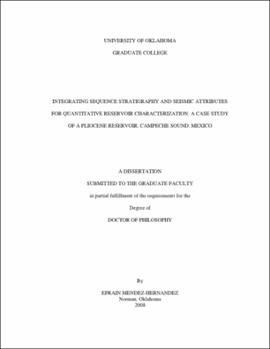| dc.contributor.advisor | SLATT, ROGER | |
| dc.creator | MENDEZ HERNANDEZ, EFRAIN | |
| dc.date.accessioned | 2019-04-27T21:30:55Z | |
| dc.date.available | 2019-04-27T21:30:55Z | |
| dc.date.issued | 2008 | |
| dc.identifier | 99259064002042 | |
| dc.identifier.uri | https://hdl.handle.net/11244/318874 | |
| dc.description.abstract | An integrated workflow including analysis of seismic, core, well log and biostratigraphic data was developed and conducted to both construct a reliable geologic model and characterize a Pliocene gas reservoir which overlies the Cantarell field in the Campeche Sound, southern Gulf of Mexico. | |
| dc.description.abstract | In 2003, the offshore exploratory Utan #1 well was drilled to investigate the gas potential of the Pliocene sequence. The well provided successful results from facies characterized by thin mixed siliciclastic-carbonate beds contained within a faulted rollover anticline. | |
| dc.description.abstract | Campeche Sound is the most prolific Mexican oil producing province where the best fields are Mesozoic-Paleocene carbonates in structural traps. Therefore, little exploration has been focused on the overlying late Tertiary and more siliciclastic section, representing a gap in the knowledge of this part of the basin where new expectations arise for non-associated gas entrapments in a traditionally oil-producing province. | |
| dc.description.abstract | Based upon development of a sequence stratigraphic framework, a new play analysis is developed where the reservoirs are identified as retrogradational shoreface parasequences sitting atop third-order sequence boundaries. Basic and advanced seismic attributes contribute to the stratigraphic interpretation and gas detection. Seismic inversion for reflectivity allowed better identification of key stratigraphic surfaces. Modeled Type-I AVO and a dimmed spectral decomposition response following structural contours provide reliability to gas discrimination and reservoir delineation. The seismic attributes will require additional support to be valuable as reservoir quality predictors. | |
| dc.description.abstract | Because biogenic methane and thin sheet reservoirs define the rock-fluid system, development may be uneconomic. However, the trapped gas could be reinjected at deeper depths to improve recovery efficiency of oil in the Cantarell field. | |
| dc.description.abstract | The knowledge gained from this research is an important contribution to the petroleum geology of Mexico and the Gulf of Mexico basin. It confirms the petroleum system for this Pliocene play, proposes a new play concept and provides the basis for further research in the study area. | |
| dc.description.abstract | Future work is recommended to extend the regional geological mapping using the integrated methodology and play analysis developed from this dissertation. New well and seismic data focused on Neogene levels should also be obtained to improve the knowledge and assure expectations for future exploration and development strategies in these and other subtle stratigraphic gas traps of this traditional oil province. | |
| dc.format.extent | 318 pages | |
| dc.format.medium | application.pdf | |
| dc.language | en_US | |
| dc.relation.requires | Adobe Acrobat Reader | |
| dc.subject | Natural gas--Prospecting--Mexico--Campeche, Bay of | |
| dc.subject | Seismic prospecting | |
| dc.subject | Geology, Stratigraphic--Pliocene | |
| dc.subject | Sequence stratigraphy | |
| dc.title | INTEGRATING SEQUENCE STRATIGRAPHY AND SEISMIC ATTRIBUTES FOR QUANTITATIVE RESERVOIR CHARACTERIZATION: A CASE STUDY OF A PLIOCENE RESERVOIR, CAMPECHE SOUND, MEXICO | |
| dc.type | text | |
| dc.type | document | |
| dc.thesis.degree | Ph.D. | |
| ou.group | Mewbourne College of Earth and Energy::ConocoPhillips School of Geology and Geophysics | |
